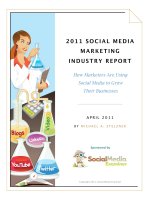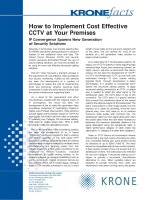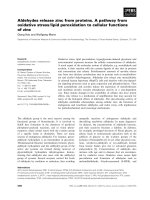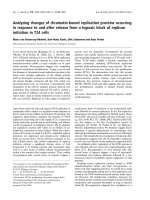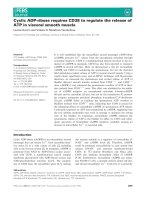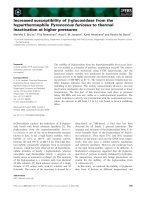media release higher margins thanks to systematic cost monitoring holcim
Bạn đang xem bản rút gọn của tài liệu. Xem và tải ngay bản đầy đủ của tài liệu tại đây (74.86 KB, 6 trang )
Corporate Communications
Holcim Ltd
Zürcherstrasse 156
CH-8645 Jona / Switzerland
Phone +41 58 858 87 10
Fax +41 58 858 87 19
Media Release
Higher margins thanks to systematic cost monitoring
Jona, August 28, 2003 – The first half of 2003 saw further increases in Holcim's
operating margins, although in Swiss franc terms the company's performance was
depressed by sharp falls in the value of major currencies compared with the first
half of 2002. Productivity gains and cost savings within the Group nevertheless had
a positive impact on earnings.
Economic conditions
A challenge was posed by the overall instability of the global economy coupled with sub-
dued investment activity in many markets. The leveling off of growth already noted in the
first quarter of 2003 has indeed become more acute. In the United States in particular, the
construction order books remained lackluster while economic conditions in Europe and
parts of Asia were also stagnant.
Sales development and financial results
In a difficult environment, Holcim maintained its position well and consolidated sales of
cement, aggregates and ready-mix concrete increased compared with the first half of
2002. North America was the only Group region to see a slight decline in cement sales.
Negative exchange rate movements impacted visibly on net sales, which decreased by
9.9% to CHF 5,804 million (first half 2002: 6,441). The US dollar alone devalued by 17.2%
compared with the corresponding prior-year period. However, delivery cutbacks owing to
the prolonged period of cold weather and tighter pricing also had a large impact. The
operating result nevertheless cushioned the effect of a generally unfavorable environment.
In the first half of the year, consolidated operating profit rose by 5.9% in local currency
terms. Because of the strength of the Swiss franc this resulted in a 5.5% decline to CHF
884 million (first half 2002: 935). Meanwhile, operating profit margin continued to increase.
This confirms that the restructuring and rationalization measures taken in previous years
have strengthened Holcim's industrial base and that the programs to cut operating costs
are feeding through. Despite the difficult starting position, net income after minority inter-
ests increased by 2.7% in local currency terms. In Swiss francs, this corresponds to a
consolidated net income of CHF 273 million (first half 2002: 292). At CHF 602 million (first
half 2002: 781), cash flow from operating activities failed to match the strong prior-year
result owing to heavy fluctuations in net working capital caused by extreme weather con-
ditions.
2/2
Continued pleasing construction activity in Southern Europe
In the first half of 2003, the European construction sector presented a variable picture in
terms of individual regional performance, but was on the whole stable. Spain and Italy en-
joyed brisk construction activity throughout the period under review. In northern parts of
Europe, there were also growing signs of a rise in demand for construction materials after
the hard winter and rather sluggish business in April and May. In Group region Europe
deliveries were up on the corresponding prior-year period in all three segments.
In Spain and Italy, Holcim consistently increased sales, and production facilities were util-
ized to capacity. The acquisition of Cementos de Hispania S.A. with retrospective effect
from January 1, 2003 has enabled Holcim Spain to strengthen its position long-term in the
country's most dynamic regional market. By contrast, Holcim France Benelux experienced
a fall in cement sales, but was able to increase deliveries of aggregates and ready-mix
concrete. In Germany, the difficult economic environment persisted and competition re-
mained extremely tight. Alsen AG, which was renamed Holcim (Deutschland) AG in May,
succeeded in maintaining its market share – albeit at a very low price level. The decline in
Switzerland mainly reflects a decrease in construction activity in the Greater Zurich region.
Cement deliveries were largely stable in Central and Eastern Europe. In particular, Group
companies in Croatia, Romania and Bulgaria made further progress.
Consolidated operating profit in Group region Europe declined by 9% in local currency
terms and 7.6% in Swiss francs to CHF 266 million (first half 2002: 288). The setback is
almost entirely due to the difficult market situation in Germany, as most European Group
companies posted better financial results thanks to restructuring measures and efficiency
gains. In some cases, the improvement was even more pronounced.
Performance depressed by weak US construction sector and currency depreciation
The North American construction sector turned in a very subdued performance, in line with
business in general in the region. Moreover, during the period under review, large parts of
North America suffered from unfavorable climatic conditions – in contrast with the mild and
dry first half of 2002. Against this background, cement deliveries in Group region North
America declined slightly while overall market share was maintained.
In the US, low interest rate levels only provided stimuli for private residential construction
activity, whereas investment in other segments of the construction market remained weak.
Holcim US succeeded in holding delivery volumes at virtually the same level as the pre-
vious year. However, demand varied from region to region, with a particularly noticeable
decline in the state of Colorado. Holcim US stepped up cement production thanks to
capacity at the new Portland plant, which in turn led to a decrease in cement and clinker
imports. What is more, June 30, 2003 saw the commissioning of the new state-of-the-art
Holly Hill plant.
The Canadian building materials market is boasting solid order books and stable prices.
However, cement sales in markets in the US North East, which are important for St.
Lawrence Cement, suffered a cyclically induced decrease of 10%. On balance, this Group
company saw its cement sales decline slightly. In the case of aggregates and ready-mix
3/3
concrete, it has not yet been possible to compensate completely for deliveries cancelled
because of bad weather at the beginning of the year, particularly in Ontario.
These negative factors, coupled with tougher competition in the South Eastern United
States, depressed the operating result by 32.5% in local currency terms. Consolidated
operating profit for North America decreased to CHF 45 million (first half 2002: 80).
Overall positive market environment and greater cost-effectiveness in Latin America
The Group's Latin American region once again performed well. Despite a mixed and
generally complex construction market environment, Holcim Group companies succeeded
in expanding cement sales year-on-year. This, coupled with a further increase in cost-
effectiveness, also led to an improvement in first-half performance.
The Mexican Group company Apasco reported a sharp rise in cement sales. By contrast,
cement deliveries declined slightly in Central America, and in Venezuela, Cementos
Caribe suffered under the political instability dogging the country throughout the period
under review. The Brazilian construction sector proved crisis-resistant despite a slacker
economy and lower cement consumption. While market conditions translated into lower
sales volumes in Holcim Brazil’s core cement segment, the company was able to signifi-
cantly increase sales of ready-mix concrete. Cemento Polpaico in Chile reported a size-
able increase in sales in both the cement and ready-mix concrete segments. Construction
activity recovered faster than expected in Argentina, resulting in a sharp rise in Minetti's
delivery volumes. In addition, Minetti has successfully concluded its debt rescheduling
negotiations with creditors and is now ideally equipped to exploit the available market
opportunities.
Latin America has made considerable progress in terms of consolidated operating profit,
up by 12.5% in US dollars. However, in Swiss franc terms, negative exchange rate trends
resulted in a decrease to CHF 385 million (first half 2002: 417).
Stable markets in Africa and the Middle East
Most of the building materials markets supplied by Holcim in Group region Africa Middle
East showed a positive development. Exceptions were Lebanon and a number of coun-
tries in the West Africa group, where there was no easing of political and economic ten-
sions. In South Africa, Group company Alpha once again exceeded the high prior-year
level of deliveries of cement and ready-mix concrete, although sales of aggregates de-
creased slightly. Holcim Morocco lifted sales in all segments. There was also an increase
in deliveries to the Indian Ocean, including Madagascar and La Réunion. In Egypt, where
Egyptian Cement Company realized the strongest increase in volume thanks to rising
cement exports, the market situation stabilized in the second quarter of 2003.
Consolidated operating profit of Group region Africa Middle East rose by 6.7% in local
currency terms. The financial result was depressed by low price levels and the devaluation
of the Egyptian pound. In Swiss franc terms, it remained virtually unchanged at CHF 121
million (first half 2002: 120). Holcim Lebanon also recorded poorer results. By contrast, the
South African Group company reported a marked improvement in financial performance
4/4
and made remarkable progress from an operating point of view. Holcim Morocco signifi-
cantly increased its contribution to profits.
Marked growth of operating profit in Asia Pacific
Group region Asia Pacific’s construction sector performed well by Group standards, al-
though in some countries economic activity lost momentum under the influence of an
unstable US economy. As a result, there was some leveling off of demand for construction
materials in specific Holcim markets. Even so, there was a slight increase in sales volumes
in the three main segments of this Group region. As a result of consolidation factors, the
Philippine Group company Union Cement posted the biggest rise in volume following its
merger with Alsons. Cement sales also increased in Vietnam and New Zealand. Siam City
Cement in Thailand and PT Semen Cibinong in Indonesia recorded declining delivery vol-
umes. Both Group companies reduced their cement exports while domestic sales re-
mained practically unchanged. Queensland Cement was unable to match its high prior-
year sales levels, but significantly improved financial results.
The consolidated operating profit of the Asia Pacific Group region rose by 36.3% in local
currency terms. Despite the sharp devaluation of the Thai baht and the Philippine peso,
operating profit increased by 20% in Swiss franc terms to CHF 96 million. This result also
reflects the continued integration of the new Indonesian business unit into the Group net-
work and the improvement in the profit situation in Thailand, Australia and New Zealand.
Sustained positive margin development
It is still generally difficult to predict business conditions in the second half of the year be-
cause of uncertainty over the US economy and exchange rate developments.
In Europe, Holcim expects to see a gradual improvement in the market situation in
Germany and overall stabilization of this Group region. Construction order books will see
an improvement in North America, particularly in Canada, while the economy remains
sluggish and US cement prices fall slightly. Latin America will continue to benefit from solid
demand for construction materials in Mexico and a further recovery in demand in Argen-
tina and Chile. The African and Asian markets should also witness a continuation of the
positive economic trend of the first six months into the next half.
Holcim is confident of a continued positive margin trend in the second half of 2003 and,
adjusting for currency factors, expects to see the previous year's financial results bettered.
5/5
Key figures
Group Holcim first half 2003 2002 +/-% +/% local
currency
Annual production capacity cement million t 141.0 141.9
11
-0.6
-0—0,
Sales of cement and clinker million t 44.8 43.5 +2.9
Sales of aggregates million t 42.9 42.3 +1.3
Sales of ready-mix concrete million m
3
12.6 12.2 +3.2
Net sales million CHF 5,804 6,441 -9.9 -1.1
Operating EBITDA million CHF 1,527 1,656 -7.8 +2.8
Operating EBITDA margin % 26.3 25.7
EBITDA million CHF 1,566 1,706 -8.2 +1.8
EBITDA margin % 27.0 26.5
Operating profit million CHF 884 935 -5.5 +5.9
Operating profit margin % 15.2 14.5
Net income before minority interests million CHF 402 427 -5.9 +5.4
Net income after minority interests million CHF 273 292 -6.5 +2.7
Net income margin % 4.7 4.5
Cash flow from operating activities million CHF 602 781 -22.9 -12.8
Cash flow margin % 10.4 12,1
Net financial debt million CHF 9,672 8,857
11
+9.2 +7.6
Shareholders' equity including interests
of minority shareholders million CHF 9,651 9,435
11
+2.3 +0.6
Gearing
2
100.2 93.9
11
Employees 30.6. 47,998 51,115
11
-6.1
Earnings per dividend-bearing share CHF 1.40 1.50 -6.7
Earnings per share (fully diluted) CHF 1.40 1.49 -6.0
Cash earnings per share
3
CHF 2.15 2.24 -4.0
Principal key figures in USD (illustrative)
4
Net sales million USD 4,299 3,952 +8.8
Operating EBITDA million USD 1,131 1,016 +11.3
Operating profit million USD 655 574 +14.2
Net income after minority interests million USD 202 179 +12.9
Cash flow from operating activities million USD 446 479 -6.9
Net financial debt million USD 7,112 6,372
11
+11.6
Shareholders' equity million USD 7,096 6,788
11
+4.5
Earnings per dividend-bearing share USD 1.04 0.92 +12.7
Principal key figures in EUR (illustrative)
4
Net sales million EUR 3,869 4,382 -11.7
Operating EBITDA million EUR 1,018 1,127 -9.6
Operating profit million EUR 589 636 -7.3
Net income after minority interests million EUR 182 199 -8.4
Cash flow from operating activities million EUR 401 531 -24.5
Net financial debt million EUR 6,240 6,108
11
+2.2
Shareholders' equity million EUR 6,226 6,507
11
-4.3
Earnings per dividend-bearing share EUR 0.93 1.02 -8.5
1
As of December 31, 2002.
2
Net financial debt divided by shareholders' equity including interests of minority shareholders.
3
Excluding the amortization of goodwill and other intangible assets.
4
Income statement figures translated at average rate; balance sheet figures at year-end rate.
6/6
You can download the complete first half-year report from www.holcim.com. There you will
also find the consolidated statement of income, consolidated balance sheet, statement of
changes in consolidated equity and the consolidated cash flow statement.
* * * * * * *
Holcim is one of the world's leading suppliers of cement, as well as aggregates (gravel and
sand), concrete and construction-related services. The Group has majority and minority interests
in more than 70 countries on all continents.
* * * * * * *
This media release is also available in German and French.
* * * * * * *
Corporate Communications: phone +41 58 858 87 10
Investor Relations: phone +41 58 858 87 87
* * * * * * *
End
